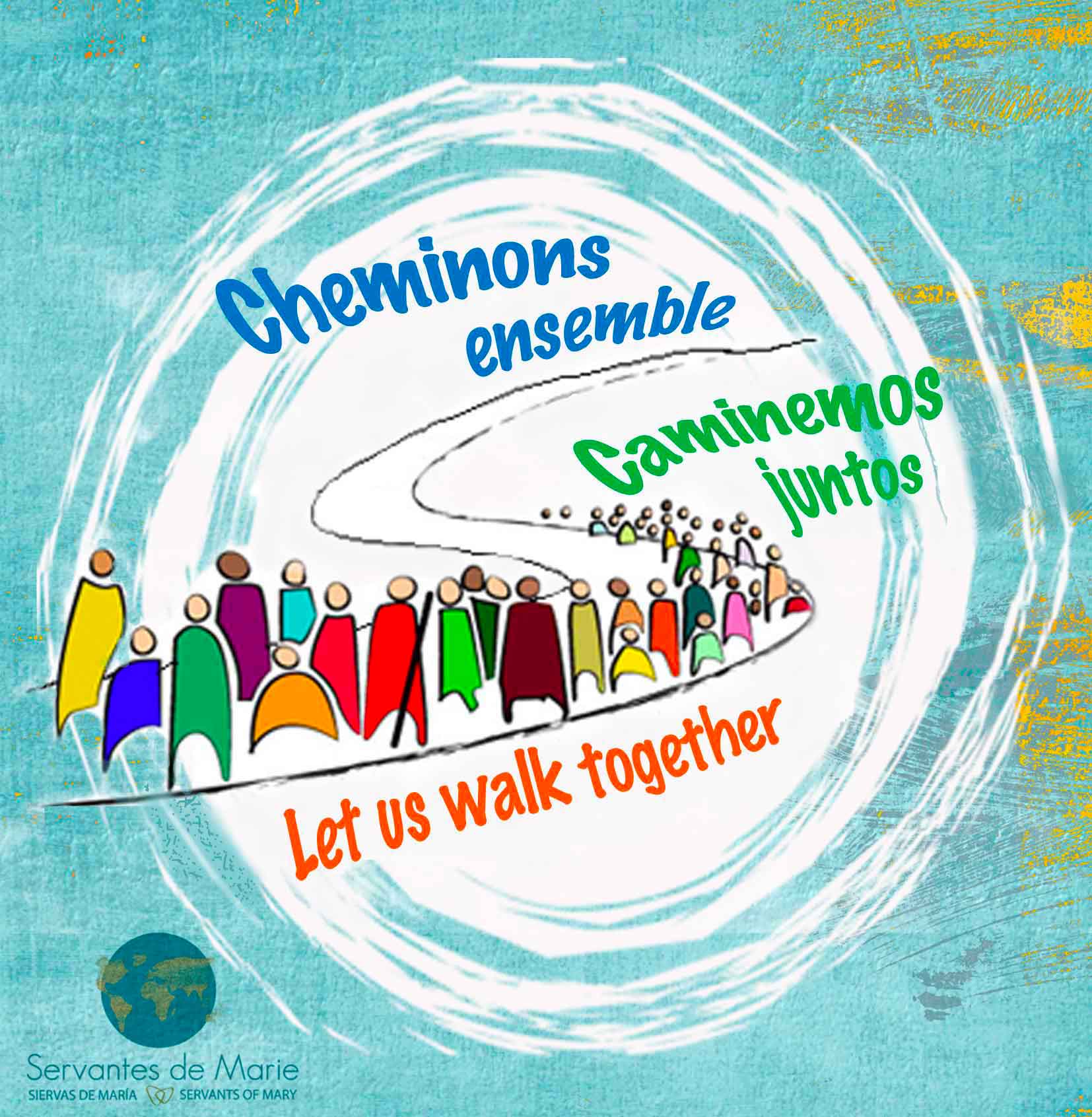
"LET'S BE PEACEMAKERS" - DECEMBER 2024
Let's walk together - Letter December 2024 
Dear readers,
here's the 3rd letter of the year, still on the theme

"Let's be Peacemakers!"
"In many places in the world, there is a need
for peacemakers who are willing to work out processes
for healing and for finding one another again." (pope Francis, Fratelli tutti § 25)
The third letter is generally devoted to testimonies and/or actions carried out in connection with the year's theme.
"Peacemakers in the Basque Country"
The Basque Country is the place of a conflict dating back over 50 years, which has resulted in deaths, victims, prisoners, suffering and deep wounds in Basque society, even today . In 2011, the Peace Process was announced at the Aiete Conference in Saint Sebastian. The Peacemakers were involved on both sides of the border: a civil dynamic, people of "good will", a hundred or so personalities representing all the political, social and trade union sensibilities of the North and South Basque Country. They have enabled ETA to disarm and are seeking to reinforce the logic of peace and dialogue in the Basque Country.

Anne-Marie Michaud, a philosophy teacher and co-president of the Basque country's human rights committee, has been actively involved in this process for several years; she's a "Artisane de la Paix". She is also the author of three books: "Tales of the Old Dove", "The Broken Jar" and "Ximun Xori or the Cowboy's Ass". She gives us her testimony:
 "Walking with the Atxik Berrituz collective (1), an actor alongside Bake Bidea (2) and the Peacemakers to prepare and live the day of April 8, 2016 was an anchoring, an articulation and a spiritual evolution in the exciting context of the Peace Process initiated in the Basque Country in 2011.
"Walking with the Atxik Berrituz collective (1), an actor alongside Bake Bidea (2) and the Peacemakers to prepare and live the day of April 8, 2016 was an anchoring, an articulation and a spiritual evolution in the exciting context of the Peace Process initiated in the Basque Country in 2011.
Being invited to take part in the meetings of this informal Christian collective turned out to be one of the nicest invitations I'd received in the Basque country, where I had to make my place since arriving there in 1973. It was an opportunity to put down roots in the Basque country and to find harmony between this part of the world and my faith, an intimate harmony comparable to the one I had experienced in Lebanon reciting the Our Father in Arabic, coming as I did from Morocco, a Muslim country where, alas, the Christian faith was lived in French. There are sometimes junctions where exile seems to come to a temporary end and 'we feel propelled towards the superior reign of the spirit', says François Cheng (1929, poet).
To live up to this invitation required an effort of articulation with my experience and commitment as a woman. At first, I perceived a large zone of unknowns and strangeness in each other's local, cultural and customary references. Then I gradually discovered what animated the members of a kind of underground church, traversed by opposing but active forces. I had only vacation memories of magnificent religious ceremonies, and I had to refocus on a new Basque church, in depth, thanks to the actors of Atxik Berrituz who lived their faith without magnificence, critically and off the beaten track. They had contacts with families affected by the conflict through their husbands, brothers or sisters, sons or daughters, imprisoned or dead militants, and possessed unprecedented, fine, subtle, essential information. They brought me closer to the world of total commitment, militant prisoners and their evolution. There was also the appreciable precaution that the existence of Atxik Berrituz remained independent of the political parties driving the Peace Process, while still living the militants' life.
Atxik Berrituz's activity was an unprecedented Christian experiment in a secularized world, showing that 'the reservoir of Catholic meaning has not disappeared from the political scene', as the researcher X. Itçaina puts it. Through the vigils organized in the parishes, I learned about the humility and courage of the testimonies, and the refusal to accept the possibility of Christians committing themselves in the name of their faith and their love of country. I came to better understand, deepen and articulate my relationship with the Basque country and its society, which is often complex, i.e. crossed by irreconcilable forces.
The tone was set from the outset: 'Atxik berrituz' means standing up and renewing oneself. Renewal is by its very nature never finished; on the contrary, it reveals a duration and an evolution experienced in the activity of the collective, but also personally in this tension towards peace.
What exactly did the meditation, prayer and singing during these vigils, prepared without any preventive measures or restrictions other than that of not hurting anyone, bring me? They enabled me to see how this 150-year-old conflict had sclerotised us, sometimes sacrificing the value of the individual and of relationships. It was often the women who bore witness, overcoming the strength of the men's voices. But above all, these prayer vigils were a bold public commitment that went beyond prejudice and habit. I saw that pain causes long-lasting suffering, isolates and divides, but I also saw and remembered that listening, speaking, watching and being listened to can break the silence and perhaps lead to less suffering. It was demanding, but it echoed my own experience, and helped me to come to terms with the fact that everyone, even the enemy or the person who simply annoys me, is worthy of his or her rights and duties. Atxik Berrituz was an unforeseen path, creative in faith, where we had to improvise our way forward, even if a certain know-how gradually took shape, modestly comparable to restorative justice.
- Political hunger for a fairer involvement of the State, the 'cold monster' as Nietzsche put it, hunger for a better union between citizens and institutions. How can I be a democratic citizen and live my faith? The peace process has been a litmus test, revealing the various forces at work within civil society and, above all, through the actions of men and women who have broken with fatality and determinism! Although my Basque nationalist feelings were at an average level, my attachment to the Basque Country was strengthened by seeing the strength of the commitments of all kinds of people to live in Basque, emerge from conflict and build a fairer society.
- Hunger for understanding of the militant's personal commitment to armed struggle, the gift of his life, the relationship with the exercise of violence, and then the possible evolution towards repentance in the abandonment of the struggle, an abandonment sometimes misunderstood by former comrades-in-arms. 'War remains an unknown territory, as does true forgiveness, which can only forgive the unforgivable', says philosopher Jacques Derrida (1930-2004). Perhaps we need to accept that this hunger for understanding has no single answer, and that this is just the way things are. Pierre Hassner (1933-2018, geopolitologist) speaks of 'an illusion that aggravates the evil when politics claims to contain or even abolish this inner violence of the human spirit that the word passion designates'.
- Hunger for justice and truth that must be brought together, says Isaiah, because the Peace Process is incomplete compared to the activists and actions of Iparretarrak (3). There is a gap to fill, a silence that goes beyond the protagonists but concerns the whole of Iparralde (4) and d'Hegoalde (5).
- Hunger for transmission, not easy to pass on the message to the younger generations, but it's also a matter of welcoming their aspirations and seeing what kind of world they want to build. How, for example, can we introduce them to the work of the Sant Egidio Community, which specializes in conflict management?
- Hunger for the meaning of history, to know whether the Basque people and the actions of men and women are part of the plan for Creation and the Kingdom of God that begins here below. What are the signs?"
Bayonne, April 8, 2017 : press article (excerpt)


On 8 April 2018, the Tree of Peace, "Arbolaren Legia" (the truth of the tree) was inaugurated Bayonne

The Tree of Peace at St. Mary's school in Biarritz
 Here are a few testimonies::
Here are a few testimonies::- Mrs Salinas' class (GS/CP)
- Message from a teacher of 10–11-year-olds:
"Since we inaugurated our Tree of Peace, every day several children ask to go right up to it. They tell me that it does them good, that they will put down their sadnesses, their worries, their fears, their arguments, their joys, their moments of success..."
- Message from the mother of a 5–6-year-old child:
"A few days ago, following painful memories of my mother's death, I was crying. My little girl came up to me and said: 'Come on, Mummy, we're going to do some breathing exercises and send up some doves of love to your mom.so she can get better and make you feel better too'."
From Argentina, the testimonies of those who give and receive help;
another form of peace and keeps the faith
- To be an artisan is to interweave the experiences of giving and receiving
- A testimony from Our Lady of Monte Grande students

A group of classmates in their final year of secondary school are part of a project that began this year, accompanying families and children who attend an "evening table" area. The project is located in a neighborhood of Monte Grande, Argentina, a few kilometers from the School of Our Lady of Monte Grande. True Peacemakers, Agustina Sarramea, Abril Sosa, Carolina López, Milagros Contrera, Chiara Vázquez, Lucía Mármol, Victoria Acevedo and Luna Ballejos bear witness to their social sensitivity:

As we journey towards Christmas, let us implore Mary, Queen of Peace
